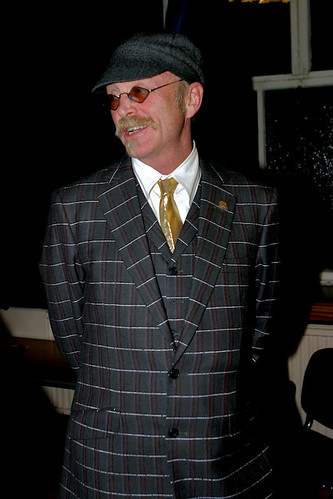So I went to the Columbia, MD, Bike-t0-Work day yesterday. As I've said before, my feelings at these affairs are mixed at best. This year was about the same as last year, although there were more practical bikes (if not cyclists!) in attendance. I found the speakers more fatuous and self-congratulatory than I remember: at least two county officials sent their aides in their stead, who dutifully reported that "[blank] couldn't be here today because of a scheduling conflict," to which I was thinking, "Yeah, at 7:30 am, it's a conflict with bed." Mostly, there was a air of patronization, of "we say we love you for what you do, but we wouldn't be caught dead doing it ourselves."
Bike-t0-Work day yesterday. As I've said before, my feelings at these affairs are mixed at best. This year was about the same as last year, although there were more practical bikes (if not cyclists!) in attendance. I found the speakers more fatuous and self-congratulatory than I remember: at least two county officials sent their aides in their stead, who dutifully reported that "[blank] couldn't be here today because of a scheduling conflict," to which I was thinking, "Yeah, at 7:30 am, it's a conflict with bed." Mostly, there was a air of patronization, of "we say we love you for what you do, but we wouldn't be caught dead doing it ourselves."
 Bike-t0-Work day yesterday. As I've said before, my feelings at these affairs are mixed at best. This year was about the same as last year, although there were more practical bikes (if not cyclists!) in attendance. I found the speakers more fatuous and self-congratulatory than I remember: at least two county officials sent their aides in their stead, who dutifully reported that "[blank] couldn't be here today because of a scheduling conflict," to which I was thinking, "Yeah, at 7:30 am, it's a conflict with bed." Mostly, there was a air of patronization, of "we say we love you for what you do, but we wouldn't be caught dead doing it ourselves."
Bike-t0-Work day yesterday. As I've said before, my feelings at these affairs are mixed at best. This year was about the same as last year, although there were more practical bikes (if not cyclists!) in attendance. I found the speakers more fatuous and self-congratulatory than I remember: at least two county officials sent their aides in their stead, who dutifully reported that "[blank] couldn't be here today because of a scheduling conflict," to which I was thinking, "Yeah, at 7:30 am, it's a conflict with bed." Mostly, there was a air of patronization, of "we say we love you for what you do, but we wouldn't be caught dead doing it ourselves."Hm. I'm betraying a seriously bad attitude here.
(Truthfully, I did seriously appreciate the Chief of Police who is a fit looking guy and a cyclist, who got up, gave an update on Maryland traffic laws -- hey, we have a Three-foot rule now! -- and admonished the crowd that you have to be respectful of traffic laws if you want respect from motorists. Hear, here.)
The county director of transportation got up and, after talking about mostly nothing for about a minute, and never mentioning any traffic improvements for cyclists, prompted me to shout, "more bike lanes!" which (to my satisfaction) nonplussed him and gained me the bemused looks of fellow cyclists. (I was hoping for a smattering of applause.)
The problem is (as it was last year) is that no one is serious about promoting biking to work. If they were serious, they'd be showing off bike lane planning for the region (assuming same existed,) they'd be touting LCI's teaching "Road 101" classes, there would be little workshops on "what you do (and don't) need to be carrying on a commuter bike." But there's none of that. There are a couple of booths for local bike shops showing off various relevant and non-relevant bikes, there are people talking all starry eyed about how they got county officials to listen to a presentation about sharrows (but no commitments of any kind), and there are county officials waxing ecstatic about how BTWD got them to practice riding so they could show up, and guess what? It was exhilarating! Plus lots of bumper stickers and tee shirts. (Where was the League of American Bicyclists?)
Look, being serious about wanting people to bike to work equals a commitment to painting bike lanes. It really is as simple as that. The few of us who are vehicular cyclists will bike to work anyway (and be perfectly safe,) but the others need bike lanes. New York City has proved this. Studies conducted over the last couple of months show a significant increase in cyclists in New York City following their painting over 200 miles of bike paths (although there is some controversy on the exact numbers). If the powers-that-be really want to encourage practical cycling for all the reasons they say, all they need to do is get out the white traffic paint.
I shouldn't be so negative about BTWD. I was in the middle of a conversation with a county official when a fellow cyclist (fully outfitted in cycling gear) came up and said, "Hey, you're the guy that I see biking to work every day, aren't you?" It made my day.





























